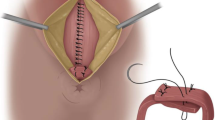Abstract
Background
Millions of people suffer from anal incontinence not currently treated due to the complexity and cost of the surgical techniques in use. The purpose of this report is to evaluate the results of anal encirclement with a simple device in a group of patients with faecal incontinence of multiple causes.
Methods
Surgery was performed as a modified Thiersch procedure through minimal perianal incisions, and a flat band of silicone was introduced to encircle the anus. Results were assessed by clinical response and objectively evaluated by comparing pre- and post-operative manometry, Jorge–Wexner and QOL (Rockwood) scores.
Results
Over a period of 5 years, this procedure was performed in 20 women and 13 men, mean age 54 years (27–86 years). Causes of incontinence were iatrogenic (5), obstetric (5), idiopathic (5), restorative proctectomy (5), rectal prolapsed (4), congenital (4), neuropathic (3), trauma (1) and mixed (1). Mortality was nil and morbidity was related to early infection (n = 2) and late skin erosion/infection (n = 2). Early or late breaking of the sling occurred in nine patients, due to the inappropriate method of closing the device. There were 13 explants: 3 as definitive and 10 re-implantations. All but one patient improved the clinical status which was objectively assessed by Jorge–Wexner and QOL scores, with significant differences.
Conclusions
This simple, safe and low-cost technique is useful for treating from disturbing soiling to severe incontinence in all those patients with failed sphincteroplasty or not amenable to sphincter repair. However, a proper device needs to be designed.

Similar content being viewed by others
References
Rasmussen O, Puggard L, Christiansen J (1999) Anal sphincter repair in patients with obstetric trauma. Dis Colon Rectum 42:193–195
Watier A (2004) Fecal incontinence: pathophysiology and treatment. Acta Endoscopica 34:605–619
Thiersch (1891) quoted in Carrasco AB (1943) Contribution a l’etude du Prolapsus du Rectum. Masson, Paris
Lomas MI, Coperman H (1972) Correction of rectal procidentia by polypropylene mesh (Marlex). Dis Colon Rectum 15:416–419
Labow S, Rubin RJ, Hoexter B et al (1980) Perineal repair of rectal procidentia with an elastic fabric sling. Dis Colon Rectum 23:467–469
Horn HR, Schoetz DJ Jr, Coller JA et al (1985) Sphincter repair with a Silastic® sling for anal incontinence and rectal procidentia. Dis Colon Rectum 28:868–872
Larach S, Vazquez B (1986) Modified Thiersch procedure with silastic mesh implant: a simple solution for fecal incontinence and severe prolapsed. South Med J 79:307–309
Keighley MRB (1993) Rectal prolapse. In: Keighley MRB, Williams NS (eds) Surgery of the anus, rectum and colon. W. B. Saunders, USA, pp 687–691
Jorge JM, Wexner SD (1993) Etiology and management of fecal incontinence. Dis Colon Rectum 36:77–97
Rockwood TH, Church JM, Flesman JW (2000) Fecal incontinence quality of life scale: quality of life instrument for patients with fecal incontinence. Dis Colon Rectum 43:9–17
Madoff RD, Rosen HR, Baeten CG et al (1999) Safety and eefficacy of dynamic muscle transplant for anal incontinence: lessons from a prospective multicenter trial. Gastroenterology 116:649–656
Devesa JM, Rey A, Lopez-Hervas P et al (2002) Artificial anal sphincter: complications and functional results of a large personal series. Dis Colon Rectum 45:1139–1153
Niriella DA, Deen KI (2002) Neosphincters in the management of faecal incontinence. Br J Surg 87:1617–1628
Ruiz MD, Alos R, Roig JV et al (2009) Long-term results of artificial bowel sphincter for the treatment of severe faecal incontinence. Are they what we hoped for? Colorectal Dis II 11:831–837
Wexner S, Hin HY, Weiss E et al (2009) Factors associated with failure of the artificial bowel sphincter: a study of over 50 cases from Cleveland Clinic Florida. Dis Colon Rectum 52:1150–1157
Dean PW, O’Brien DP, Turk MA et al (1988) Silicone elastomer sling for fecal incontinence in dogs. Vet Surg 17:304–310
Khanduja KS, Hardy TG, Aguilar PS et al (1988) A new silicone prosthesis in the modified Thiersch operation. Dis Colon Rectum 31:380–383
Author information
Authors and Affiliations
Corresponding author
Rights and permissions
About this article
Cite this article
Devesa, J.M., Hervás, P.L., Vicente, R. et al. Anal encirclement with a simple prosthetic sling for faecal incontinence. Tech Coloproctol 15, 17–22 (2011). https://doi.org/10.1007/s10151-010-0673-1
Received:
Accepted:
Published:
Issue Date:
DOI: https://doi.org/10.1007/s10151-010-0673-1




